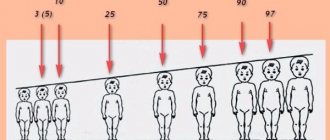The height of a 4 year old child, what should it be? All parents, without exception, worry about the child’s mental and mental development, as well as his physical compliance with gender and age. The growth of a child is one of the indicators of a child’s good physical development. Let's figure out how to determine whether a 4-year-old child is small, large or normal.
The growth standards of a 4-year-old child are determined using a formula or special centile tables. There are tables below, but now we will look at the formulas and growth standards that can be used to calculate whether the growth of a 4-year-old child is normal.
Growth norms
In the first year, a child grows by approximately twenty-five centimeters, and in the first half of the year - by sixteen to seventeen centimeters, and in the second - by eight centimeters. Starting from the 2nd year of life, a slowdown in growth is observed, and by the end of 2 years the child grows by ten to twelve centimeters. Then, until the age of five, every year the baby gains six centimeters in height, a maximum of eight, and from five years until puberty, each year the increase is five to six centimeters.
The second growth spurt occurs during puberty. By the end of puberty, the body gains approximately twenty to twenty-five centimeters in height. But the increase in growth is uneven. Moreover, the most significant growth spurt occurs in the year of greatest hormonal activity. In such a year, a teenager can grow eight to ten centimeters. This year is starting in completely different ways for all children. All this is within the normal range.
It’s not often that mothers complain about their child’s short stature relative to his peers at school, but suddenly within 1 year, often over the summer, the boy grows up, “stretches out” and becomes taller than all his classmates.
Also, when determining the height of a 4-year-old child, it is necessary to take into account nationality, heredity, and life characteristics, for example, if the child is involved in any sports.
Average height of men and women in Russia and other countries
Comment added by: Anna Date: 2017-02-27
Author, my height is only 160-161 cm, I am already 32 years old and, of course, even if I had turned to some growth hormones, it certainly would not have corrected the situation by a mm, perhaps in width (which I personally I would be afraid if I pricked myself).Wherever I find myself, I hear the phrase: “Oh, you’re so small,” although I don’t wear shoes shorter than 12-14 cm. Perhaps I have similar characteristics to the above because of my narrow bones and graceful constitution , although I can’t be called thin either (Russian sizes are 40-42, outerwear is 42-44), but my figure is still more feminine, hourglass than athletic. It seems to me that almost all the girls and women in whose company I find myself (even just in a subway car or on a bus) noticeably taller than me (see 10, or even more). I don’t think that the average height of a Russian woman is 166. My sister, if you believe her, is 167-168 (size 40). She is too thin in build. So she looks significantly taller than me and also calls me petty. Before For 32 years I didn’t even think about my height, and the other day I drowned in complexes. Some kind of internal breakdown happened. Probably also because, as if on purpose, at every step only tall and very tall women are advertised, admired and glorified (from 177 cm ).And also as thin as possible (no matter the fat). Even my parents, brothers and sister, colleagues, former classmates (by the way, barely reaching the average, or even lower) always laughed at me and openly said that real beauties are tall, but they called me names, of course , a trifle. I came across VictoriasSecret shows on the Internet and felt like a complete insignificance. Oh, if only I had 10-15 cm to my figure, I would be no worse than these catwalk models. And then I read about one model of about 173 cm, which More than one agency did not want to accept and did not take a single pass, calling her the offensive word “dwarf,” and in the end, thanks to the patronage of one of the shortest (if we call a spade a spade a spade) catwalk models Kate Moss, she was invited to work at VictoriasSecret.Very I’m happy for her, but still, I have to admit that she doesn’t look good on the catwalk. She’s stockier and significantly shorter than all the other angels. Neither the famous wings nor the flowing capes look on her the same way as on other models from 180 and above. Needed endless legs!.. Even if the legs are from the ears, still with a height of 160-170 they will (as a rule) be lower than those who are taller, see 10-15. And for podium work and for life, probably , this is also still important, no matter how you look at it. At work they call me long-legged, but what are my legs compared to the length of my boss’s legs, who are 180 cm. And it doesn’t matter to anyone that the models have a foot size of at least 40, that their shoulder span is the same as men’s, that they have men’s hands and that they have far from the mythical 90-60-90. Even looking at the photo, you understand how huge they are. But the lack of fat and tall height do their job and give such an optical illusion. Although, of course, even much larger parameters for such tall ladies are quite acceptable and will still not make them plump and plump, unlike us small ones who turn into barrels, it’s worth gaining 5-6 extra kg. Of course, there are many articles where miniature women are consoled that happiness is not in height, not everyone can walk on the catwalk, your purpose is something else. However, contrary to the phrase: big women are for work, and small ones are for work, it turns out that these big ones walk around on the catwalks, reveling in ourselves, fame and money, and we, the little ones, work, work, work in offices, not seeing the light of day, and even receiving anti-complements at every step. What a happy life!..After everything I have written, the reader may get the impression that I am just another petty envious person and a loser. Not at all! I am an esthete. I love beautiful people and am sincerely happy for those of us who are truly beautiful. Yes, yes, I understand that true beauty is also a subjective concept, but we will appeal to the standard concepts proposed, I would even say, imposed on us by modern society about standard beauty (beauties no lower than 175, no more than 50 kg, having parameters no more than 90-60-90, and better even less). In short, neither comforting articles, nor even happiness in my personal life make me feel better. Maybe, against the backdrop of depression, I’m also having a midlife crisis. Believe it or not, until I was 32, I didn’t even think about my height, although I was always worried about my figure and always “held” it with all my might. And then suddenly, literally overnight, something radically changed in my worldview and I became fixated on my height, which can hardly even be called height... I don’t eat, I don’t drink, I can’t work, I’ve lost the meaning of life. , I just sit and feel sad, and at night I shed tears, as if this will make me grow... I have abandoned everything, neglected it, nothing interests me and brings me pleasure.
Growth formulas
For small children under six months: 66 minus 2× age per month. Thus, if the baby is three months old, then 66 minus 2x3 equals 60 cm. These are average figures.
For babies from six months to 1 year: 66 plus 1.5 cm × number of months that have passed after 6 months. That is, if the baby is seven months old, then after six months only 1 month has passed, which means 66 plus 1.5 times 1 month. = 64.5 cm.
For children under four years old: 100 minus 8 x (4 minus b) = height in cm (b – age in years).
For children over four years old: 100 plus 6 x (minus 4) = height in cm (in – age in years).
What are nanism and gigantism?
Nanism is a clinical syndrome that is caused by various endocrine and non-endocrine diseases in children. In common people, short stature. There are several types of pathological growth changes.
Pituitary short stature is a disease caused by disruption of the endocrine system. At 3, 4, 6 years of age, the disease can be caused by a head injury or severe intoxication of the body.
Symptomatic short stature develops against the background of tumors present in the hypothalamus or pituitary gland, heart disease, and diseases of the liver and renal system. Diagnosed between the ages of 2 and 6 years.
Gigantism most often develops in childhood, because some processes of ossification of the musculoskeletal system remain incomplete. With this pathology, at the age of three or four years, the child’s growth rate far exceeds anatomical and physiological norms. At the end of puberty, growth of approximately 2 m is noted.
The disease occurs in the presence of tumors in the adenohypophysis, damage to the nervous system by a bacterial or viral infection (meningitis, encephalitis). A common cause of growth impairment at the age of 3 years is intoxication of the body (poisoning with food or chemicals). Gigantism can result from traumatic brain injury.
To prevent growth disturbances in a child, children should be provided with a nutritious diet from infancy, rich in a balanced amount of proteins, carbohydrates, fats, vitamins, and minerals. Keep an eye on the kids and prevent injuries.
What if you suspect your baby is short?
You need to immediately consult an endocrinologist and undergo all the necessary tests to determine possible abnormalities. Bone age is also determined. If the bone age is less than the child’s age, it means there is still potential for growth. If this indicator is higher, then a thorough examination and a doctor’s appointment are needed. Often, for better growth, it is necessary to prescribe the right diet, rich in calcium, proteins, phosphorus, vitamin A, as well as some physical exercise (swimming, exercise on the horizontal bar, jumping, and so on.)
Factors affecting child growth
Genetic factors:
set the limits of the baby's biological growth potential, and in addition the growth rate. They are quite closely intertwined with environmental factors that affect growth.
That is, if the baby’s parents are short, then the likelihood of the baby being short is also very high. However, under good external conditions - excellent nutrition, the absence of diseases that adversely affect growth, a good emotional and social background in the family, you can confidently count on a large growth of a 4-year-old child compared to his parents. In this regard, the following example is quite indicative: it was determined that the tribe of African pygmies has such a short stature only due to the lack of protein in their diet. When the tribe's children were switched to a protein-rich diet, they grew almost twice as tall as their parents.
It was also found that special physical exercises have an excellent effect on the baby, despite his poor genetics, which increase the growth rate of a 4-year-old child, stimulating the growth zones of the long tubular bones and the spine.
External environmental factors, which include:
Negative effects during the period of intrauterine formation or after childbirth, which disrupts the development and growth of the fetus. These effects can be of different nature - immunological, physical, chemical, or the result of infection.
Nutritional factors that affect growth (vitamins, microelements, salts, complete proteins) can be closely intertwined with economic and social factors.
Emotional and social factors that can change growth potential include the nature of the baby’s relationship with mom and dad, his position in the family, and the parents’ own interests and needs.
That is, in general we can say that the development and growth of a 4-year-old child is the result of the combined influence of a complex set of factors on him, both external environmental and genetic.
What should a 5 year old child be able to do?
An important part of education is developed speech. As a rule, by the age of five, a child’s vocabulary already reaches 3,000 words. But you shouldn’t expect complex sentences from him - emotional and restless, the baby does not spend time thinking about how to express his thoughts and uses simple forms. Although he already knows how to retell more complex sentences, except that he does not compose them himself - everything has its time.
The speech of a 5-year-old child is full of various concepts, simple antonyms; he can not only name an object, but also say what it is made of and what it is needed for. He knows how to distinguish which hand is his right and which is his left, although he may make a mistake when showing it to other people. Can count to ten.
At this age, a child absorbs any information that interests him like a sponge. His memory is still based on emotions, on short-term interest. Quantity prevails over the quality of memorability and by the end of the day he may forget about everything he recently heard or saw. In this case, memory-developing exercises and games will help.
At the age of five, children's social maturity is still small, but they are already learning to interact with other children. It is important to monitor this process so that social adaptation for the child is painless, especially if he did not go to a nursery or kindergarten. The baby begins to understand that he is not the center of the Universe and that besides him there are other children, just like himself. Missing this moment in upbringing may complicate the child’s stay among peers in the future.
The child is already better oriented in space and knows how to use various spatial concepts, such as: go left, go up, go down a floor, etc.
For him, there is already a difference between the past, the present and the not yet to come. However, orientation in time durations is still difficult, especially in assessing time intervals: year, month, week, day, season, minutes and hours. It is still difficult for a child to imagine the duration of something.
The five-year student begins to understand that there are reversible and irreversible processes, distinguishes one situation from another if something has changed in the first, but remains unchanged in the second. For example, that the number of his cubes, which were scattered on the floor and now collected in a heap, remained unchanged, only the form of their organization changed.
One of the most important aspects of development is the activation of imagination. It becomes the basis for many discoveries, primarily independent ones, which is especially important. The child begins to solve simple arithmetic problems and count out loud on his fingers. He better distinguishes geometric shapes and knows how to create them himself from available materials.
The rapidly developing imagination of young children often frightens parents, who sometimes consider it abnormal if the child communicates with imaginary friends or sees what his imagination draws. But this is a normal phenomenon and wild imagination becomes the basis for the harmonious development of the individual. Creative thinking contributes to a child’s better understanding of the world around him.
How to take height measurements correctly?
Measuring a child's body length
In order to measure the baby’s body length as accurately as possible, you need to take into account the following points when he stands at the measuring scale:
- Socks and shoes must be removed. And although socks do not greatly affect the baby's height, they can hide his attempts to appear taller by standing on tiptoes than he really is. Excess hair decorations must also be removed.
- The baby should stand on the base of the height measurement unit with his back to the vertical tripod. At the same time, his shoulders should be strictly at the same level, and his arms should be extended at the seams. In turn, the heels, buttocks, shoulder blades, and back of the head should touch the vertical tripod. The child's legs should be straight, and the heels should be pressed firmly to the base.
- The baby's head must be placed so that the auditory canal and the lower edge of the eye socket are on the same horizontal line and parallel to the base of the device. In order to fix the baby's head in this position, the area where the index finger and thumb connect should be lightly pressed above his chin. Fixing the head in this position, with the other hand you need to lower the bar so that it completely touches the top of the head and presses the child’s hair.
- When you are convinced that the baby is standing correctly at the measuring scale, you need to ask him to take a deep breath and then exhale. The readings are taken as you exhale.
- The height of a 4-year-old child must be read exactly to the nearest millimeter; numbers are not rounded.
Information from Russian pediatricians and WHO specialists
For many decades, the World Health Organization has been keeping statistics on height, weight and other parameters of children of different ages to derive average data. Based on these figures, normal values and indicators are formed, which are taken as the starting point in many clinics and child care institutions around the world.
Pediatricians in Russia keep their own individual statistics, which also contain information for many years. However, the data from WHO and domestic experts are slightly different. This is due to factors that are taken into account when calculating averages: nutrition, physical activity, hereditary factors and the environment.
In any case, parents should remember that small deviations from the norm are allowed subject to certain reasons and conditions. A pediatrician can figure this out and give recommendations.











